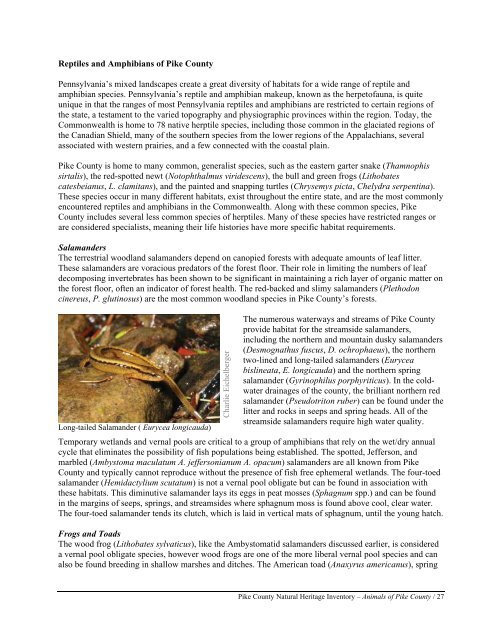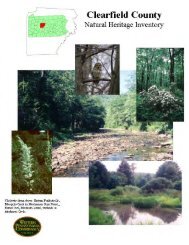Pike CNHI - Pennsylvania Natural Heritage Program
Pike CNHI - Pennsylvania Natural Heritage Program
Pike CNHI - Pennsylvania Natural Heritage Program
Create successful ePaper yourself
Turn your PDF publications into a flip-book with our unique Google optimized e-Paper software.
Reptiles and Amphibians of <strong>Pike</strong> County<br />
<strong>Pennsylvania</strong>’s mixed landscapes create a great diversity of habitats for a wide range of reptile and<br />
amphibian species. <strong>Pennsylvania</strong>’s reptile and amphibian makeup, known as the herpetofauna, is quite<br />
unique in that the ranges of most <strong>Pennsylvania</strong> reptiles and amphibians are restricted to certain regions of<br />
the state, a testament to the varied topography and physiographic provinces within the region. Today, the<br />
Commonwealth is home to 78 native herptile species, including those common in the glaciated regions of<br />
the Canadian Shield, many of the southern species from the lower regions of the Appalachians, several<br />
associated with western prairies, and a few connected with the coastal plain.<br />
<strong>Pike</strong> County is home to many common, generalist species, such as the eastern garter snake (Thamnophis<br />
sirtalis), the red-spotted newt (Notophthalmus viridescens), the bull and green frogs (Lithobates<br />
catesbeianus, L. clamitans), and the painted and snapping turtles (Chrysemys picta, Chelydra serpentina).<br />
These species occur in many different habitats, exist throughout the entire state, and are the most commonly<br />
encountered reptiles and amphibians in the Commonwealth. Along with these common species, <strong>Pike</strong><br />
County includes several less common species of herptiles. Many of these species have restricted ranges or<br />
are considered specialists, meaning their life histories have more specific habitat requirements.<br />
Salamanders<br />
The terrestrial woodland salamanders depend on canopied forests with adequate amounts of leaf litter.<br />
These salamanders are voracious predators of the forest floor. Their role in limiting the numbers of leaf<br />
decomposing invertebrates has been shown to be significant in maintaining a rich layer of organic matter on<br />
the forest floor, often an indicator of forest health. The red-backed and slimy salamanders (Plethodon<br />
cinereus, P. glutinosus) are the most common woodland species in <strong>Pike</strong> County’s forests.<br />
Long-tailed Salamander ( Eurycea longicauda)<br />
Charlie Eichelberger<br />
The numerous waterways and streams of <strong>Pike</strong> County<br />
provide habitat for the streamside salamanders,<br />
including the northern and mountain dusky salamanders<br />
(Desmognathus fuscus, D. ochrophaeus), the northern<br />
two-lined and long-tailed salamanders (Eurycea<br />
bislineata, E. longicauda) and the northern spring<br />
salamander (Gyrinophilus porphyriticus). In the coldwater<br />
drainages of the county, the brilliant northern red<br />
salamander (Pseudotriton ruber) can be found under the<br />
litter and rocks in seeps and spring heads. All of the<br />
streamside salamanders require high water quality.<br />
Temporary wetlands and vernal pools are critical to a group of amphibians that rely on the wet/dry annual<br />
cycle that eliminates the possibility of fish populations being established. The spotted, Jefferson, and<br />
marbled (Ambystoma maculatum A. jeffersonianum A. opacum) salamanders are all known from <strong>Pike</strong><br />
County and typically cannot reproduce without the presence of fish free ephemeral wetlands. The four-toed<br />
salamander (Hemidactylium scutatum) is not a vernal pool obligate but can be found in association with<br />
these habitats. This diminutive salamander lays its eggs in peat mosses (Sphagnum spp.) and can be found<br />
in the margins of seeps, springs, and streamsides where sphagnum moss is found above cool, clear water.<br />
The four-toed salamander tends its clutch, which is laid in vertical mats of sphagnum, until the young hatch.<br />
Frogs and Toads<br />
The wood frog (Lithobates sylvaticus), like the Ambystomatid salamanders discussed earlier, is considered<br />
a vernal pool obligate species, however wood frogs are one of the more liberal vernal pool species and can<br />
also be found breeding in shallow marshes and ditches. The American toad (Anaxyrus americanus), spring<br />
<strong>Pike</strong> County <strong>Natural</strong> <strong>Heritage</strong> Inventory – Animals of <strong>Pike</strong> County / 27










